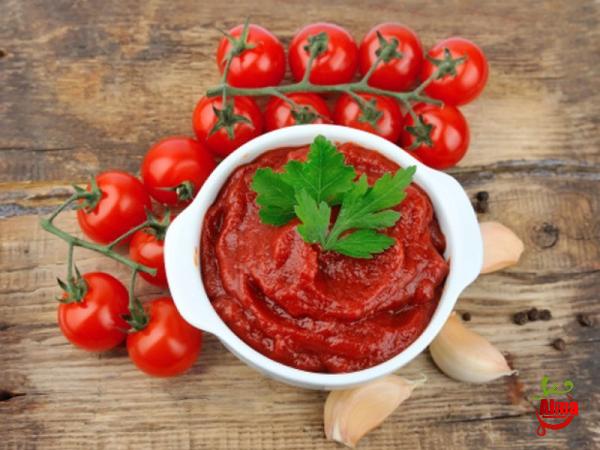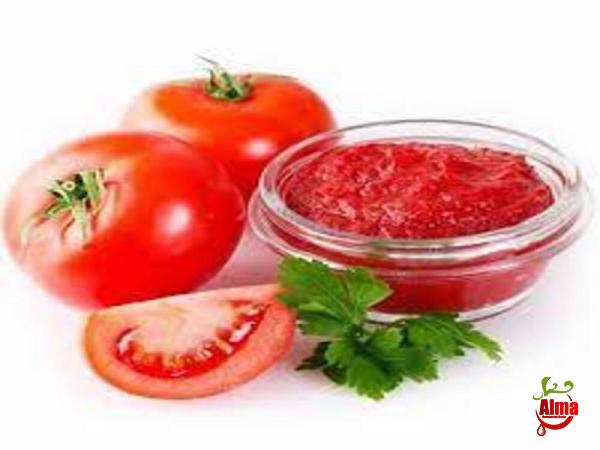Exploring Alternative to Tomato Paste: A Guide to Delicious Substitutes Introduction: Tomato paste is a popular ingredient used in a wide range of savory dishes, providing a rich and deep flavor to soups, stews, sauces, and more. However, there are instances when you may find yourself in need of a substitute for tomato paste. Whether it’s due to dietary restrictions, personal preferences, or simply because you’ve run out of tomato paste in your pantry, there are several alternatives that can offer comparable flavors and textures. In this article, we will explore some of these alternatives and provide you with creative ways to use them in your cooking. 1. Canned Tomatoes: One of the closest alternatives to tomato paste is using canned tomatoes. Crushed, diced, or pureed canned tomatoes can all be used as substitutes, depending on the recipe. To achieve a tomato paste-like consistency, you can simmer the canned tomatoes until the mixture has thickened, and the excess liquid has evaporated. This method provides a similar depth of flavor to tomato paste, albeit with a slightly milder taste. Adjusting the seasoning may be necessary to balance the flavors. 2. Sun-Dried Tomatoes: Sun-dried tomatoes are intensely flavored and concentrated, making them a great alternative to tomato paste. They offer a robust and slightly sweet taste that can elevate your dishes. To use sun-dried tomatoes as a substitute, soak them in hot water for about 15-20 minutes to rehydrate. Once softened, blend them into a paste-like consistency, adding a little water or olive oil if needed. The resulting paste can be used in recipes that call for tomato paste, lending a unique and tangy flavor to your dishes.

tomato paste
 3. Tomato Sauce: Tomato sauce, commonly used as a base for pasta dishes, can also serve as a substitute for tomato paste. It provides a thinner consistency compared to tomato paste but can be used to achieve a similar flavor profile. To thicken tomato sauce, simmer it on low heat until it reduces and thickens to your desired consistency. Note that you may need to adjust the seasoning to compensate for the added liquid in the sauce. 4. Tomato Soup: If you have a can of tomato soup handy, you can use it as an alternative to tomato paste in certain recipes. Tomato soup is flavorful and already thickened, making it suitable for recipes like stews or casseroles. Start by reducing the soup over low heat to intensify the flavor and thicken it further. Keep in mind that tomato soup may contain additional seasonings, so adjust the overall seasoning accordingly. 5. Roasted Red Peppers: Roasted red peppers can add a unique flavor profile and vibrancy to dishes, making them a creative alternative to tomato paste. They possess a natural sweetness and a smoky undertone that works well in various recipes. To use roasted red peppers as a substitute, puree them in a blender or food processor until a paste-like consistency is achieved. You may need to add a little water or olive oil to reach the desired texture. The resulting paste can be used as a flavorful replacement in dishes that call for tomato paste, giving your recipes a delightful twist. 6. Red Paprika Paste: Red paprika paste, commonly used in Mediterranean and Eastern European cuisine, can be a suitable substitute for tomato paste. Made from roasted red peppers or chilies, this paste offers a deep and slightly tangy flavor. Its vibrant red color adds an appealing visual element to your dishes. When using red paprika paste as a substitute, keep in mind that it has a spicier profile compared to tomato paste. Adjust the quantity according to your preferences.
3. Tomato Sauce: Tomato sauce, commonly used as a base for pasta dishes, can also serve as a substitute for tomato paste. It provides a thinner consistency compared to tomato paste but can be used to achieve a similar flavor profile. To thicken tomato sauce, simmer it on low heat until it reduces and thickens to your desired consistency. Note that you may need to adjust the seasoning to compensate for the added liquid in the sauce. 4. Tomato Soup: If you have a can of tomato soup handy, you can use it as an alternative to tomato paste in certain recipes. Tomato soup is flavorful and already thickened, making it suitable for recipes like stews or casseroles. Start by reducing the soup over low heat to intensify the flavor and thicken it further. Keep in mind that tomato soup may contain additional seasonings, so adjust the overall seasoning accordingly. 5. Roasted Red Peppers: Roasted red peppers can add a unique flavor profile and vibrancy to dishes, making them a creative alternative to tomato paste. They possess a natural sweetness and a smoky undertone that works well in various recipes. To use roasted red peppers as a substitute, puree them in a blender or food processor until a paste-like consistency is achieved. You may need to add a little water or olive oil to reach the desired texture. The resulting paste can be used as a flavorful replacement in dishes that call for tomato paste, giving your recipes a delightful twist. 6. Red Paprika Paste: Red paprika paste, commonly used in Mediterranean and Eastern European cuisine, can be a suitable substitute for tomato paste. Made from roasted red peppers or chilies, this paste offers a deep and slightly tangy flavor. Its vibrant red color adds an appealing visual element to your dishes. When using red paprika paste as a substitute, keep in mind that it has a spicier profile compared to tomato paste. Adjust the quantity according to your preferences.
Specifications of tomato paste
 Conclusion: While tomato paste is a versatile ingredient that enhances the flavors of many dishes, it’s reassuring to know that there are several alternatives available. From canned tomatoes to sun-dried tomatoes, tomato sauce to tomato soup, roasted red peppers to red paprika paste, this article has covered a range of options to consider when you need to substitute tomato paste. Experiment with these alternatives to find the best fit for your cuisine, taking into account flavor profiles, textures, and specific dietary requirements. Remember, cooking is all about creativity, and these alternatives provide ample room for exploring new depths of flavors in your favorite recipes.Exploring the Business Potential of Alternative Tomato Paste Substitutes 1. Market Demand and Trends: The market for alternative tomato paste substitutes is driven by various factors, including dietary restrictions such as allergies or specific diets, evolving food preferences, and the need to cater to a diverse consumer base. As more people adopt vegetarian, vegan, or gluten-free lifestyles, the demand for alternative ingredients becomes increasingly crucial. In addition, the growing interest in global cuisines and fusion cooking has paved the way for a wider acceptance and exploration of different flavors and ingredients, including alternatives to traditional tomato paste. 2. Health Benefits and Nutritional Value: Alternative tomato paste substitutes offer health benefits and nutritional value that appeal to health-conscious consumers. For example, using sun-dried tomatoes or red paprika paste in place of tomato paste introduces additional vitamins, minerals, and antioxidants to the dish. Sun-dried tomatoes are high in lycopene, which is known to have antioxidant properties and potential health benefits. Red paprika paste, on the other hand, contains high levels of Vitamin C and carotenoids. By incorporating these ingredients into recipes, consumers can enhance their nutrient intake while enjoying delicious meals. 3. Sustainable Sourcing and Production: As sustainability continues to be a key concern for both consumers and businesses, alternative tomato paste substitutes provide an excellent opportunity to promote eco-friendly practices. Sun-dried tomatoes, for instance, can be sourced from local farmers or made at home using surplus tomatoes, reducing food waste. Roasted red peppers and their byproducts can also be obtained from local or organic sources. By supporting sustainable sourcing and production methods, businesses can align themselves with environmentally conscious consumers and contribute to a greener future. 4. Culinary Innovation and Menu Expansion: Integrating alternative tomato paste substitutes into recipes allows for culinary innovation and menu expansion in restaurants, food businesses, and catering services. By incorporating ingredients like roasted red pepper paste or red paprika paste, chefs can infuse unique and enticing flavors into their dishes, setting them apart from competitors. This leads to increased customer satisfaction, repeat business, and positive word-of-mouth recommendations.
Conclusion: While tomato paste is a versatile ingredient that enhances the flavors of many dishes, it’s reassuring to know that there are several alternatives available. From canned tomatoes to sun-dried tomatoes, tomato sauce to tomato soup, roasted red peppers to red paprika paste, this article has covered a range of options to consider when you need to substitute tomato paste. Experiment with these alternatives to find the best fit for your cuisine, taking into account flavor profiles, textures, and specific dietary requirements. Remember, cooking is all about creativity, and these alternatives provide ample room for exploring new depths of flavors in your favorite recipes.Exploring the Business Potential of Alternative Tomato Paste Substitutes 1. Market Demand and Trends: The market for alternative tomato paste substitutes is driven by various factors, including dietary restrictions such as allergies or specific diets, evolving food preferences, and the need to cater to a diverse consumer base. As more people adopt vegetarian, vegan, or gluten-free lifestyles, the demand for alternative ingredients becomes increasingly crucial. In addition, the growing interest in global cuisines and fusion cooking has paved the way for a wider acceptance and exploration of different flavors and ingredients, including alternatives to traditional tomato paste. 2. Health Benefits and Nutritional Value: Alternative tomato paste substitutes offer health benefits and nutritional value that appeal to health-conscious consumers. For example, using sun-dried tomatoes or red paprika paste in place of tomato paste introduces additional vitamins, minerals, and antioxidants to the dish. Sun-dried tomatoes are high in lycopene, which is known to have antioxidant properties and potential health benefits. Red paprika paste, on the other hand, contains high levels of Vitamin C and carotenoids. By incorporating these ingredients into recipes, consumers can enhance their nutrient intake while enjoying delicious meals. 3. Sustainable Sourcing and Production: As sustainability continues to be a key concern for both consumers and businesses, alternative tomato paste substitutes provide an excellent opportunity to promote eco-friendly practices. Sun-dried tomatoes, for instance, can be sourced from local farmers or made at home using surplus tomatoes, reducing food waste. Roasted red peppers and their byproducts can also be obtained from local or organic sources. By supporting sustainable sourcing and production methods, businesses can align themselves with environmentally conscious consumers and contribute to a greener future. 4. Culinary Innovation and Menu Expansion: Integrating alternative tomato paste substitutes into recipes allows for culinary innovation and menu expansion in restaurants, food businesses, and catering services. By incorporating ingredients like roasted red pepper paste or red paprika paste, chefs can infuse unique and enticing flavors into their dishes, setting them apart from competitors. This leads to increased customer satisfaction, repeat business, and positive word-of-mouth recommendations.
buy tomato paste
 5. Product Diversification and Differentiation: For businesses involved in manufacturing or packaging food products, offering alternative tomato paste substitutes presents an opportunity for product diversification and differentiation. Creating tomato paste alternatives in different forms, such as ready-to-use pastes, concentrated powders, or flavored spreads, allows companies to tap into niche markets and cater to specific consumer needs. By offering a range of options, businesses can better serve customers with diverse dietary requirements and preferences. 6. Collaboration and Partnerships: Collaborating with local farms, suppliers, and niche food producers can be mutually beneficial for businesses looking to incorporate alternative tomato paste substitutes into their offerings. This allows smaller, specialized producers to reach a wider audience, while the businesses gain access to unique and high-quality ingredients. Collaborative efforts can also help in promoting sustainable practices, supporting local economies, and creating a sense of community and shared values among consumers. 7. Packaging and Labeling Considerations: When marketing alternative tomato paste substitutes, businesses should prioritize clear and informative packaging and labeling. Providing detailed descriptions of the substitute’s flavor profile, ingredients, and potential uses can help consumers make informed choices. Highlighting the nutritional benefits, organic or sustainable certifications, and allergen information can further enhance consumer trust and confidence in the products. Eye-catching design and appealing visuals can also attract attention and drive sales. 8. Online Presence and Recipe Inspiration: To promote and sell alternative tomato paste substitutes, businesses should establish a strong online presence. Creating user-friendly websites or e-commerce platforms allows consumers to easily access products, browse recipes, and make purchases. Engaging consumers through social media platforms, cooking blogs, or e-newsletters can provide recipe inspiration, cooking tips, and build a loyal customer base. Encouraging user-generated content, such as sharing customer recipes and experiences, can further strengthen brand loyalty and foster a sense of community. 9. Culinary Education and Workshops: To encourage the adoption of alternative tomato paste substitutes, businesses can organize culinary education events or workshops. These events can educate both professionals and home cooks about the benefits, uses, and techniques for incorporating substitutes into their cooking. Demonstrating the versatility of alternative ingredients and providing hands-on experiences can increase consumer confidence in trying new products and recipes. 10. Market Research and Customer Feedback: Businesses should regularly conduct market research to stay informed about changing consumer preferences, emerging trends, and competitors’ activities. Engaging with customers through surveys, feedback forms, or focus groups can provide valuable insights into their needs, preferences, and satisfaction levels. This feedback can assist businesses in refining existing products, developing new offerings, and tailoring marketing strategies to meet consumer demands more effectively. Conclusion: Embracing alternative tomato paste substitutes can open up new opportunities for businesses to meet the evolving needs and preferences of consumers in the culinary landscape. From catering to dietary restrictions to promoting sustainability, diversifying product offerings, and engaging with customers, businesses can leverage these substitutes to enhance their market presence and differentiate themselves from competitors. By embracing innovation, collaboration, and consumer education, businesses can tap into the rising demand for alternative tomato paste substitutes and build a strong foundation for success in the dynamic and ever-changing food industry.
5. Product Diversification and Differentiation: For businesses involved in manufacturing or packaging food products, offering alternative tomato paste substitutes presents an opportunity for product diversification and differentiation. Creating tomato paste alternatives in different forms, such as ready-to-use pastes, concentrated powders, or flavored spreads, allows companies to tap into niche markets and cater to specific consumer needs. By offering a range of options, businesses can better serve customers with diverse dietary requirements and preferences. 6. Collaboration and Partnerships: Collaborating with local farms, suppliers, and niche food producers can be mutually beneficial for businesses looking to incorporate alternative tomato paste substitutes into their offerings. This allows smaller, specialized producers to reach a wider audience, while the businesses gain access to unique and high-quality ingredients. Collaborative efforts can also help in promoting sustainable practices, supporting local economies, and creating a sense of community and shared values among consumers. 7. Packaging and Labeling Considerations: When marketing alternative tomato paste substitutes, businesses should prioritize clear and informative packaging and labeling. Providing detailed descriptions of the substitute’s flavor profile, ingredients, and potential uses can help consumers make informed choices. Highlighting the nutritional benefits, organic or sustainable certifications, and allergen information can further enhance consumer trust and confidence in the products. Eye-catching design and appealing visuals can also attract attention and drive sales. 8. Online Presence and Recipe Inspiration: To promote and sell alternative tomato paste substitutes, businesses should establish a strong online presence. Creating user-friendly websites or e-commerce platforms allows consumers to easily access products, browse recipes, and make purchases. Engaging consumers through social media platforms, cooking blogs, or e-newsletters can provide recipe inspiration, cooking tips, and build a loyal customer base. Encouraging user-generated content, such as sharing customer recipes and experiences, can further strengthen brand loyalty and foster a sense of community. 9. Culinary Education and Workshops: To encourage the adoption of alternative tomato paste substitutes, businesses can organize culinary education events or workshops. These events can educate both professionals and home cooks about the benefits, uses, and techniques for incorporating substitutes into their cooking. Demonstrating the versatility of alternative ingredients and providing hands-on experiences can increase consumer confidence in trying new products and recipes. 10. Market Research and Customer Feedback: Businesses should regularly conduct market research to stay informed about changing consumer preferences, emerging trends, and competitors’ activities. Engaging with customers through surveys, feedback forms, or focus groups can provide valuable insights into their needs, preferences, and satisfaction levels. This feedback can assist businesses in refining existing products, developing new offerings, and tailoring marketing strategies to meet consumer demands more effectively. Conclusion: Embracing alternative tomato paste substitutes can open up new opportunities for businesses to meet the evolving needs and preferences of consumers in the culinary landscape. From catering to dietary restrictions to promoting sustainability, diversifying product offerings, and engaging with customers, businesses can leverage these substitutes to enhance their market presence and differentiate themselves from competitors. By embracing innovation, collaboration, and consumer education, businesses can tap into the rising demand for alternative tomato paste substitutes and build a strong foundation for success in the dynamic and ever-changing food industry.









Your comment submitted.